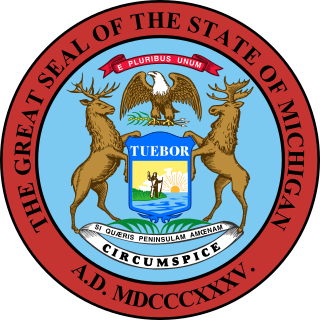External links
Members of the Connecticut State Senate | ||
|---|---|---|
| ||
| ||
The Lieutenant Governor of Connecticut serves as the President of the Connecticut Senate, but only casts a vote if required to break a tie. In his or her absence, the President Pro Tempore of the Connecticut Senate presides. The President pro tempore is elected by the majority party caucus followed by confirmation of the entire Senate through a Senate Resolution. The President pro tempore is the chief leadership position in the Senate. The Senate majority and minority leaders are elected by their respective party caucuses.
The current President pro tempore of the Connecticut Senate is Martin M. Looney, a Democrat who has served since 2015.

The Michigan Senate is the upper house of the Michigan Legislature. Along with the Michigan House of Representatives, it composes the state legislature, which has powers, roles and duties defined by Article IV of the Michigan Constitution, adopted in 1963. The primary purpose of the Legislature is to enact new laws and amend or repeal existing laws.

The Mississippi Senate is the upper house of the Mississippi Legislature, the state legislature of the U.S. state of Mississippi. The Senate, along with the lower Mississippi House of Representatives, convenes at the Mississippi State Capitol in Jackson.
The following table indicates the party of elected officials in the U.S. state of New York:

The Connecticut State Senate is the upper house of the Connecticut General Assembly, the state legislature of the U.S. state of Connecticut. The state senate comprises 36 members, each representing a district with around 99,280 inhabitants. Senators are elected to two-year terms without term limits. The Connecticut State Senate is one of 14 state legislative upper houses whose members serve two-year terms; four-year terms are more common.

The Democratic Party of Illinois is the affiliate of the Democratic Party in the U.S. state of Illinois. It is the oldest extant state party in Illinois and one of just two recognized parties in the state, along with the Republican Party. It is currently the dominant party in the state, controlling the majority of Illinois' U.S. House seats, both U.S. Senate seats, both houses of the state legislature, and the governorship.

The following is a list of lieutenant governors of the State of Connecticut.

The Delaware Senate is the upper house of the Delaware General Assembly, the state legislature of the U.S. state of Delaware. It is composed of 21 Senators, each of whom is elected to a four-year term, except when reapportionment occurs, at which time Senators may be elected to a two-year term. There is no limit to the number of terms that a Senator may serve. The Delaware Senate meets at the Legislative Hall in Dover.
President of the Kentucky Senate is an office created by a 1992 amendment to the Constitution of Kentucky. The president of the Senate is the highest-ranking officer of that body and presides over the Senate.

The Majority leader of the New York State Senate is elected by the majority of the members of the New York State Senate. The position usually coincides with the title of temporary president of the State Senate, who presides over the session of the State Senate if the lieutenant governor of New York is absent. The temporary president of the State Senate becomes acting lieutenant governor for the remainder of the unexpired term in case of a vacancy in the office of lieutenant governor, or until a new lieutenant governor is appointed In case of a vacancy in the offices of both the governor and lieutenant governor at the same time, the temporary president of the State Senate becomes Acting Governor. If the double vacancy occurs until three months before the mid-term state elections, a special election for governor of New York and lieutenant governor is held. If the double vacancy occurs later, the Temporary President of the State Senate acts as governor until the end of the unexpired term. The temporary president of the State Senate retains both majority leadership and a seat in the State Senate while acting as lieutenant governor or governor.

The Legislature of the State of Oklahoma is the state legislative branch of the U.S. state of Oklahoma. The Oklahoma House of Representatives and Oklahoma Senate are the two houses that make up the bicameral state legislature. There are 101 state representatives, each serving a two-year term, and 48 state senators, who serve four-year terms that are staggered so only half of the Oklahoma Senate districts are eligible in each election cycle. Legislators are elected directly by the people from single member districts of equal population. The Oklahoma Legislature meets annually in the Oklahoma State Capitol in Oklahoma City.

The Indiana Senate is the upper house of the Indiana General Assembly, the state legislature of the U.S. state of Indiana. The Senate is composed of 50 members representing an equal number of constituent districts. Senators serve four-year terms without term limits. According to the 2010 U.S. census, the average state senator represents 129,676 people.

The Oklahoma Senate is the upper house of the two houses of the Legislature of Oklahoma, the other being the Oklahoma House of Representatives. The total number of senators is set at 48 by the Oklahoma Constitution.

The President pro tempore of the Oklahoma Senate is the second-highest-ranking official of the Oklahoma Senate and the highest-ranking state senator. The Oklahoma Constitution designates the Lieutenant Governor of Oklahoma as the highest-ranking official, serving ex officio as President of the Senate, even though the lieutenant governor only votes in the case of a tie. During the lieutenant governor's absence, the president pro tempore presides over sessions. By longstanding custom, the lieutenant governor presides over sessions devoted to ceremonial purposes, while the bulk of the legislative management and political power is reserved for the president pro tempore, who is elected directly by the Oklahoma Senate.

The Louisiana State Senate is the upper house of the state legislature of Louisiana. All senators serve four-year terms and are assigned to multiple committees.

The Connecticut Democratic State Central Committee is the affiliate of the Democratic Party in the state of Connecticut. Its chair is Nancy DiNardo.

The lieutenant governor of Indiana is a constitutional office in the US state of Indiana. Republican Suzanne Crouch, who assumed office January 9, 2017, is the incumbent. The office holder's constitutional roles are to serve as the president of the Indiana Senate, become acting governor during the incapacity of the governor, and become governor should the incumbent governor resign, die in office, or be impeached and removed from office. Lieutenant governors have succeeded ten governors following their deaths or resignations. The lieutenant governor holds statutory positions, serving as the head of the state agricultural and rural affairs bureaus, and as the chairman of several state committees. The annual salary of the lieutenant governor is $88,000.
The following table indicates the party of elected officials in the U.S. state of Connecticut:
The following table indicates the party of elected officials in the U.S. state of Minnesota: